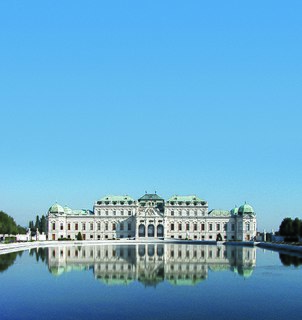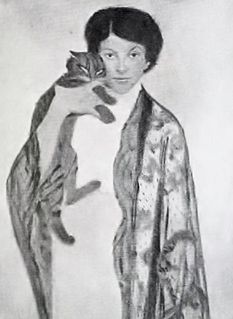
Richard Gerstl was an Austrian painter and draughtsman known for his expressive psychologically insightful portraits, his lack of critical acclaim during his lifetime, and his affair with the wife of Arnold Schoenberg which led to his suicide.

The Österreichische Galerie Belvedere is a museum housed in the Belvedere palace, in Vienna, Austria.

Olga Wisinger-Florian was an Austrian impressionist painter, mainly of landscapes and flower still life. She was a representative of the Austrian "Stimmungsimpressionismus", a loose group of Austrian impressionist painters that was considered avant-garde in the 1870s and 1880s.

Arik Brauer was an Austrian painter, printmaker, poet, dancer, singer-songwriter, stage designer, architect, and academic teacher.

Josef Danhauser was an Austrian painter, one of the main artists of Biedermeier period, together with Ferdinand Georg Waldmüller, Peter Fendi, among others. His works, not very appreciated in his time, dealt with very moralising subjects and had a clear influence of William Hogarth.
George Mayer-Marton was a Hungarian Jewish artist who was a significant figure in Viennese art between the First and Second World Wars, working in oil, watercolour and graphics. Following his forced emigration to England in 1938, he continued to paint in watercolour and oil. He pioneered the technique of Byzantine mosaic in the UK.

Tobias G. Natter is an Austrian art historian and internationally renowned art expert particularly for "Vienna around 1900".

Marie Egner was an Austrian painter.
Ilse Haider is an Austrian artist. She focuses on photography and her photographic works use three dimensional surfaces. She has received a number of awards for her work and her work has appeared in exhibitions throughout Europe and the United States.
Richard Hirschbäck was an Austrian painter. He was a founding member of the Austrian artist group Gruppe 77.
Hildegard Joos was an Austrian painter and is known as the "Grande Dame" of geometric abstraction and constructivism in Austria.

Ilse von Twardowski or Ilse Twardowski-Conrat (1880–1942) was an Austrian sculptor. She created many noted sculptures. She took her own life in 1942 as a result of the Holocaust.

Hermine Heller-Ostersetzer (1874-1909) was an Austrian painter and graphic artist.

Frida Konstantin (1884–1918) was an Austrian-Hungarian artist.

Lilly Steiner (1884–1961) was an Austrian painter and graphic artist.

Helene von Taussig (1879-1942) was an Austrian painter.

Grete Wolf Krakauer née Wolf (1890-1970) was an Austrian-Israeli painter.
Franziska Zach (1900-1930) was an Austrian painter.
Johanna Kampmann-Freund (1888-1940) was an Austrian painter and in 1927 was the first woman to win the Austrian State Prize.
Lotte Profohs, also Lotte Profohs-Leherb, was an Austrian graphic artist and painter who was close to Expressionism.














